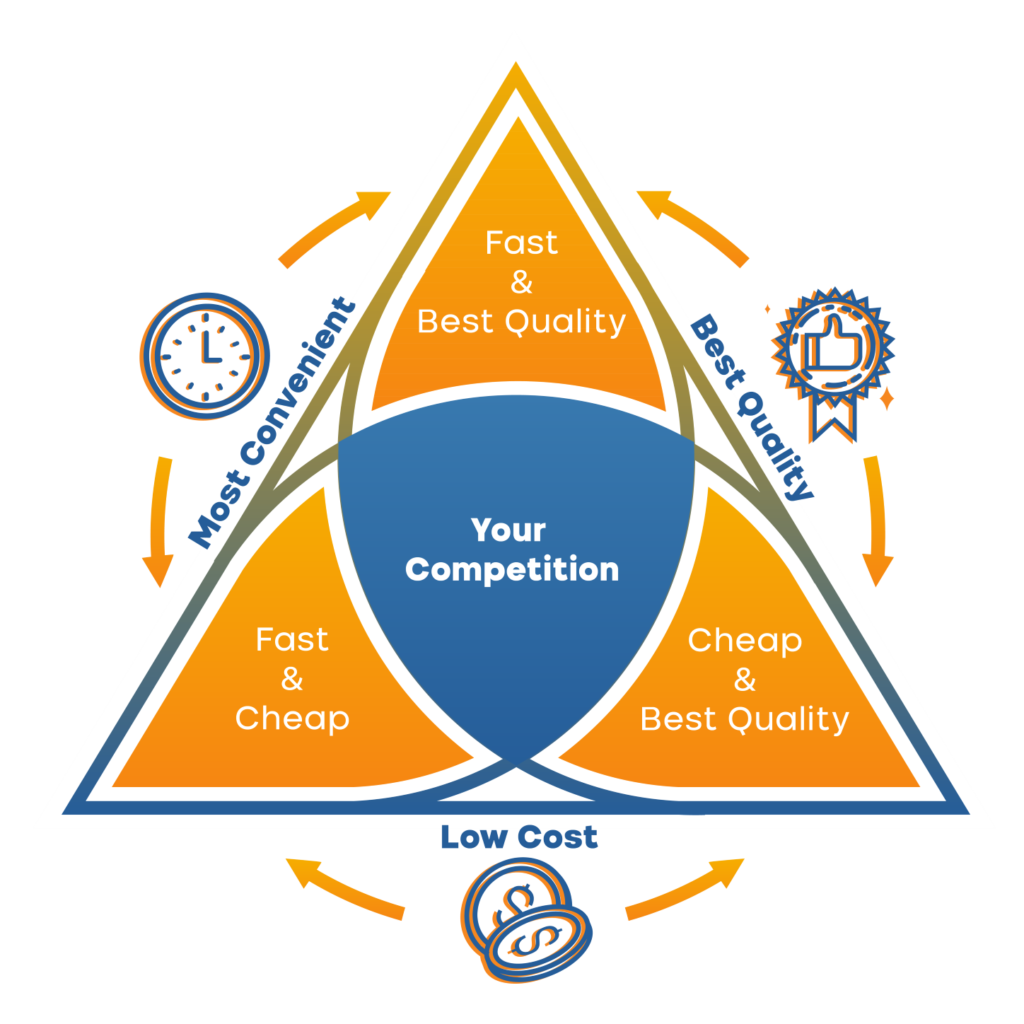In the world of business, it’s inevitable to have competitors that offer similar products, services, and experiences to what your own business offers.
This is the very reason why you’re supposed to set your business apart from the rest.
The struggle most businesses face with this, however, is that they don’t have the laser sharp focus they need in order to properly differentiate their business from their competitors.
After all, there is a proper method to determine how to find your business’ niche, and to finally apply this knowledge to your future branding and strategies.
So how is this possible with today’s seemingly cutthroat ecosystem of business and capitalism?

Keeping the Triangle in Mind
A common mistake businesses make when it comes to setting their business’ goals and intentions is choosing to focus on what everyone wants. While wanting to be the best in every aspect is ideal and well-intentioned, in reality, this only creates a scattered business plan and business method.
The truth of the matter is: you can’t please anyone. If you don’t see it now, you will definitely see it in practice.
One important visualization to keep in mind when choosing your business’ focus is the triangle. The triangle has three key points: affordability, convenience, and quality.
While these three points all exist on the triangle, you cannot choose all three, else you’re bound to neglect all three.
Choosing one or two points to focus on, on the other hand, will give your business a stable base and a great niche to work with.
Take a look at the successful businesses right now. They may seem to cater to a wide audience, however, if you take a closer look into what they’re promising their customers, they’re actually being very specific about their offerings.
Take Netflix, for example. Netflix has built their media streaming empire around convenience. This is their niche, and this is what they set as their utmost priority when continuing to provide their products and services to their clients. In fact, they made convenience their priority so much that they’ve become the best at providing it. It might’ve helped that their competitors at the time did not think of revolutionizing convenience and integrating it to new technologies available then.
It is this niche that customers come back for— it is this niche that a brand or a business gets known for reliably offering. While it can’t cater to all audiences, it will build trust among its target audience, with the possibility of converting future audiences.
Amazon is another good example of a big business with a niche. They set themselves apart from the rest of their competitors by giving Prime features to its subscribers— for a fee. They may be compromising on cost, but they provide their customers the kind of quality that keeps them coming back.
Finally, there’s Shoetopia.ca. These shoe stores provide footwear that aren’t considered cheap on average, but since Shoetopia promises to provide a high quality experience to its target audience and the convenience of shopping quickly and locally, it’s effectively found its niche.

How to Differentiate your Business’ Products from the Rest
Now that you know about avoiding spreading your business’ focus onto all three points of the notorious triangle, you might be wondering: how can you differentiate your business’ products from the rest of your competitors’?
This ties us back to some topics we’ve discussed prior, particularly: the Five Ps. Particularly, we need to work on the very root of our product, which is our business’ Promise— in order to reliably produce that final P, which is Profit.
Choosing where to focus your efforts translates into what you end up promising your customers. With Shoetopia, they promise high quality shoes that can be quickly sourced and delivered. That is its edge over its competitors.
With Amazon, they may have added an extra cost for Prime features, but they promise to provide excellent quality services not offered anywhere else.
It’s all a matter of choosing which audience you want to cater to, getting to know their common issues within your business space, and choosing the method you want to go about solving their issues.
Upon gaining this understanding of your target audience, you’ll end up with a better grasp of how to interact with them, and how to cater to them.
Again, you can’t please them all, but you can continuously make patrons out of those who are bound to trust your brand due to the needs your products answer.
Of course, you have to solve people’s problems while setting your business apart from the rest, which is where the triangle comes in. Ask yourself: which points are my competitors currently focusing on? Which points can I focus on that will differentiate my business?

The bottom line is, you have to be clear about your intentions from start to finish. These intentions and goals— these promises— have a way of getting reflected into your branding, your marketing, and your actual products and services.
Without any clarity, even your internal team is bound to be confused about your product.
Remember: clarity propels confidence within your team— and if it does that effectively, it will propel this all the more to your customers, building trust as you go along.
Finally, once everything is set, and all your differentiations and promises are set into motion, you can be propelled into producing higher profits.




0 Comments